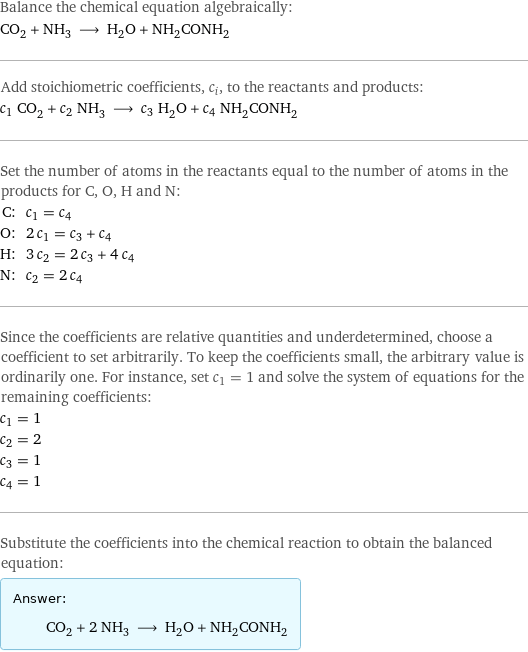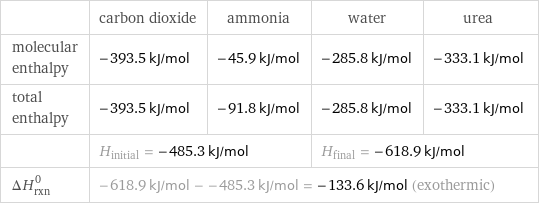Input interpretation

CO_2 carbon dioxide + NH_3 ammonia ⟶ H_2O water + NH_2CONH_2 urea
Balanced equation

Balance the chemical equation algebraically: CO_2 + NH_3 ⟶ H_2O + NH_2CONH_2 Add stoichiometric coefficients, c_i, to the reactants and products: c_1 CO_2 + c_2 NH_3 ⟶ c_3 H_2O + c_4 NH_2CONH_2 Set the number of atoms in the reactants equal to the number of atoms in the products for C, O, H and N: C: | c_1 = c_4 O: | 2 c_1 = c_3 + c_4 H: | 3 c_2 = 2 c_3 + 4 c_4 N: | c_2 = 2 c_4 Since the coefficients are relative quantities and underdetermined, choose a coefficient to set arbitrarily. To keep the coefficients small, the arbitrary value is ordinarily one. For instance, set c_1 = 1 and solve the system of equations for the remaining coefficients: c_1 = 1 c_2 = 2 c_3 = 1 c_4 = 1 Substitute the coefficients into the chemical reaction to obtain the balanced equation: Answer: | | CO_2 + 2 NH_3 ⟶ H_2O + NH_2CONH_2
Structures

+ ⟶ +
Names

carbon dioxide + ammonia ⟶ water + urea
Reaction thermodynamics
Enthalpy

| carbon dioxide | ammonia | water | urea molecular enthalpy | -393.5 kJ/mol | -45.9 kJ/mol | -285.8 kJ/mol | -333.1 kJ/mol total enthalpy | -393.5 kJ/mol | -91.8 kJ/mol | -285.8 kJ/mol | -333.1 kJ/mol | H_initial = -485.3 kJ/mol | | H_final = -618.9 kJ/mol | ΔH_rxn^0 | -618.9 kJ/mol - -485.3 kJ/mol = -133.6 kJ/mol (exothermic) | | |
Equilibrium constant
![Construct the equilibrium constant, K, expression for: CO_2 + NH_3 ⟶ H_2O + NH_2CONH_2 Plan: • Balance the chemical equation. • Determine the stoichiometric numbers. • Assemble the activity expression for each chemical species. • Use the activity expressions to build the equilibrium constant expression. Write the balanced chemical equation: CO_2 + 2 NH_3 ⟶ H_2O + NH_2CONH_2 Assign stoichiometric numbers, ν_i, using the stoichiometric coefficients, c_i, from the balanced chemical equation in the following manner: ν_i = -c_i for reactants and ν_i = c_i for products: chemical species | c_i | ν_i CO_2 | 1 | -1 NH_3 | 2 | -2 H_2O | 1 | 1 NH_2CONH_2 | 1 | 1 Assemble the activity expressions accounting for the state of matter and ν_i: chemical species | c_i | ν_i | activity expression CO_2 | 1 | -1 | ([CO2])^(-1) NH_3 | 2 | -2 | ([NH3])^(-2) H_2O | 1 | 1 | [H2O] NH_2CONH_2 | 1 | 1 | [NH2CONH2] The equilibrium constant symbol in the concentration basis is: K_c Mulitply the activity expressions to arrive at the K_c expression: Answer: | | K_c = ([CO2])^(-1) ([NH3])^(-2) [H2O] [NH2CONH2] = ([H2O] [NH2CONH2])/([CO2] ([NH3])^2)](../image_source/d97628340e81cc212524377a3dc675e9.png)
Construct the equilibrium constant, K, expression for: CO_2 + NH_3 ⟶ H_2O + NH_2CONH_2 Plan: • Balance the chemical equation. • Determine the stoichiometric numbers. • Assemble the activity expression for each chemical species. • Use the activity expressions to build the equilibrium constant expression. Write the balanced chemical equation: CO_2 + 2 NH_3 ⟶ H_2O + NH_2CONH_2 Assign stoichiometric numbers, ν_i, using the stoichiometric coefficients, c_i, from the balanced chemical equation in the following manner: ν_i = -c_i for reactants and ν_i = c_i for products: chemical species | c_i | ν_i CO_2 | 1 | -1 NH_3 | 2 | -2 H_2O | 1 | 1 NH_2CONH_2 | 1 | 1 Assemble the activity expressions accounting for the state of matter and ν_i: chemical species | c_i | ν_i | activity expression CO_2 | 1 | -1 | ([CO2])^(-1) NH_3 | 2 | -2 | ([NH3])^(-2) H_2O | 1 | 1 | [H2O] NH_2CONH_2 | 1 | 1 | [NH2CONH2] The equilibrium constant symbol in the concentration basis is: K_c Mulitply the activity expressions to arrive at the K_c expression: Answer: | | K_c = ([CO2])^(-1) ([NH3])^(-2) [H2O] [NH2CONH2] = ([H2O] [NH2CONH2])/([CO2] ([NH3])^2)
Rate of reaction
![Construct the rate of reaction expression for: CO_2 + NH_3 ⟶ H_2O + NH_2CONH_2 Plan: • Balance the chemical equation. • Determine the stoichiometric numbers. • Assemble the rate term for each chemical species. • Write the rate of reaction expression. Write the balanced chemical equation: CO_2 + 2 NH_3 ⟶ H_2O + NH_2CONH_2 Assign stoichiometric numbers, ν_i, using the stoichiometric coefficients, c_i, from the balanced chemical equation in the following manner: ν_i = -c_i for reactants and ν_i = c_i for products: chemical species | c_i | ν_i CO_2 | 1 | -1 NH_3 | 2 | -2 H_2O | 1 | 1 NH_2CONH_2 | 1 | 1 The rate term for each chemical species, B_i, is 1/ν_i(Δ[B_i])/(Δt) where [B_i] is the amount concentration and t is time: chemical species | c_i | ν_i | rate term CO_2 | 1 | -1 | -(Δ[CO2])/(Δt) NH_3 | 2 | -2 | -1/2 (Δ[NH3])/(Δt) H_2O | 1 | 1 | (Δ[H2O])/(Δt) NH_2CONH_2 | 1 | 1 | (Δ[NH2CONH2])/(Δt) (for infinitesimal rate of change, replace Δ with d) Set the rate terms equal to each other to arrive at the rate expression: Answer: | | rate = -(Δ[CO2])/(Δt) = -1/2 (Δ[NH3])/(Δt) = (Δ[H2O])/(Δt) = (Δ[NH2CONH2])/(Δt) (assuming constant volume and no accumulation of intermediates or side products)](../image_source/c5b1de3f541c514164d5cf8c7916e4e4.png)
Construct the rate of reaction expression for: CO_2 + NH_3 ⟶ H_2O + NH_2CONH_2 Plan: • Balance the chemical equation. • Determine the stoichiometric numbers. • Assemble the rate term for each chemical species. • Write the rate of reaction expression. Write the balanced chemical equation: CO_2 + 2 NH_3 ⟶ H_2O + NH_2CONH_2 Assign stoichiometric numbers, ν_i, using the stoichiometric coefficients, c_i, from the balanced chemical equation in the following manner: ν_i = -c_i for reactants and ν_i = c_i for products: chemical species | c_i | ν_i CO_2 | 1 | -1 NH_3 | 2 | -2 H_2O | 1 | 1 NH_2CONH_2 | 1 | 1 The rate term for each chemical species, B_i, is 1/ν_i(Δ[B_i])/(Δt) where [B_i] is the amount concentration and t is time: chemical species | c_i | ν_i | rate term CO_2 | 1 | -1 | -(Δ[CO2])/(Δt) NH_3 | 2 | -2 | -1/2 (Δ[NH3])/(Δt) H_2O | 1 | 1 | (Δ[H2O])/(Δt) NH_2CONH_2 | 1 | 1 | (Δ[NH2CONH2])/(Δt) (for infinitesimal rate of change, replace Δ with d) Set the rate terms equal to each other to arrive at the rate expression: Answer: | | rate = -(Δ[CO2])/(Δt) = -1/2 (Δ[NH3])/(Δt) = (Δ[H2O])/(Δt) = (Δ[NH2CONH2])/(Δt) (assuming constant volume and no accumulation of intermediates or side products)
Chemical names and formulas

| carbon dioxide | ammonia | water | urea formula | CO_2 | NH_3 | H_2O | NH_2CONH_2 Hill formula | CO_2 | H_3N | H_2O | CH_4N_2O name | carbon dioxide | ammonia | water | urea